Abstract
Data are summarized from 152 single-subject analyses of the reinforcing functions of self-injurious behavior (SIB). Individuals with developmental disabilities referred for assessment and/or treatment over an 11-year period were exposed to a series of conditions in which the effects of antecedent and consequent events on SIB were examined systematically by way of multielement, reversal, or combined designs. Data were collected during approximately 4,000 experimental sessions (1,000 hr), with the length of assessment for individuals ranging from 8 to 66 sessions (M = 26.2) conducted over 2 to 16.5 hr (M = 6.5). Differential or uniformly high responding was observed in 145 (95.4%) of the cases. Social—negative reinforcement (escape from task demands or other sources of aversive stimulation) accounted for 58 cases, which was the largest proportion of the sample (38.1%). Social—positive reinforcement (either attention or access to food or materials) accounted for 40 (26.3%) of the cases, automatic (sensory) reinforcement accounted for 39 (25.7%), and multiple controlling variables accounted for 8 (5.3%). Seven sets of data (4.6%) showed either cyclical or inconsistent patterns of responding that were uninterpretable. Overall results indicated that functional analysis methodologies are extremely effective in identifying the environmental determinants of SIB on an individual basis and, subsequently, in guiding the process of treatment selection. Furthermore, an accumulation of assessment data from such analyses across a large number of individuals provides perhaps the most rigorous approach to an epidemiological study of behavioral function.
Keywords: epidemiology, functional analysis, self-injurious behavior
Full text
PDF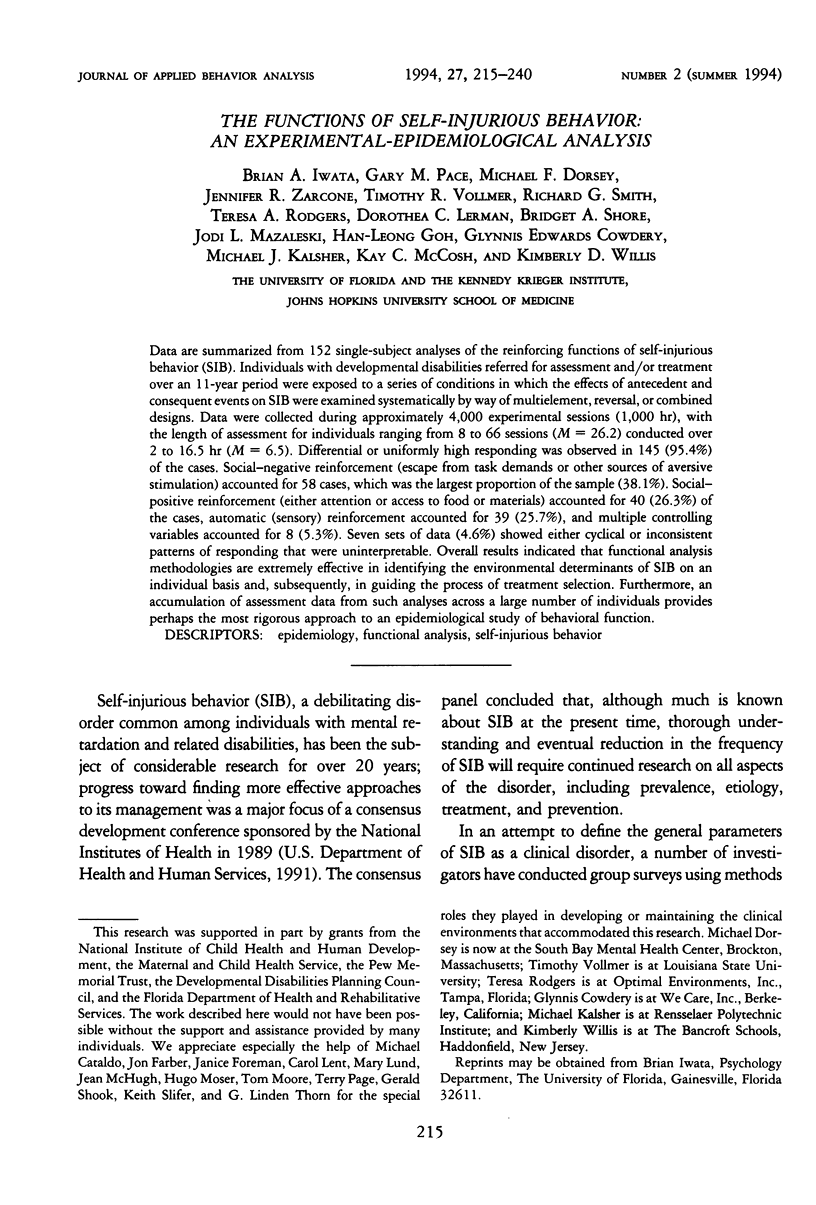
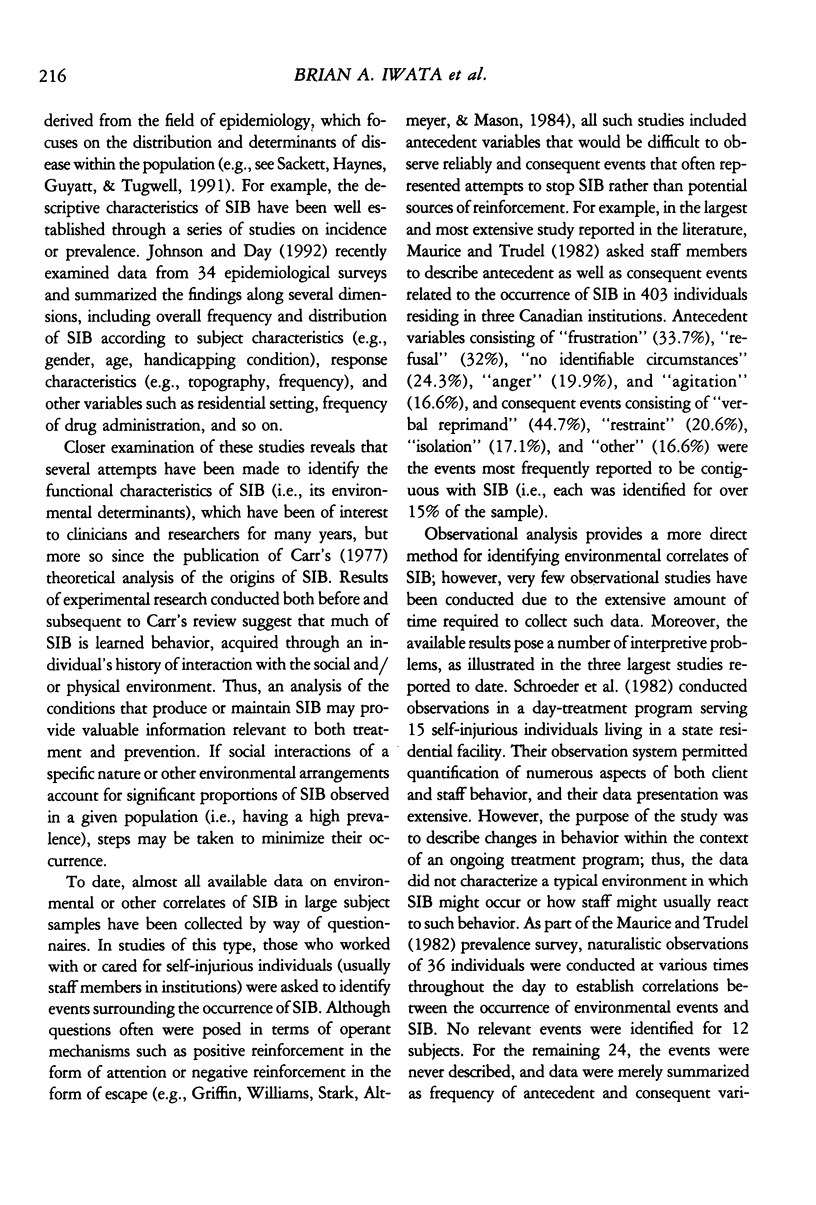
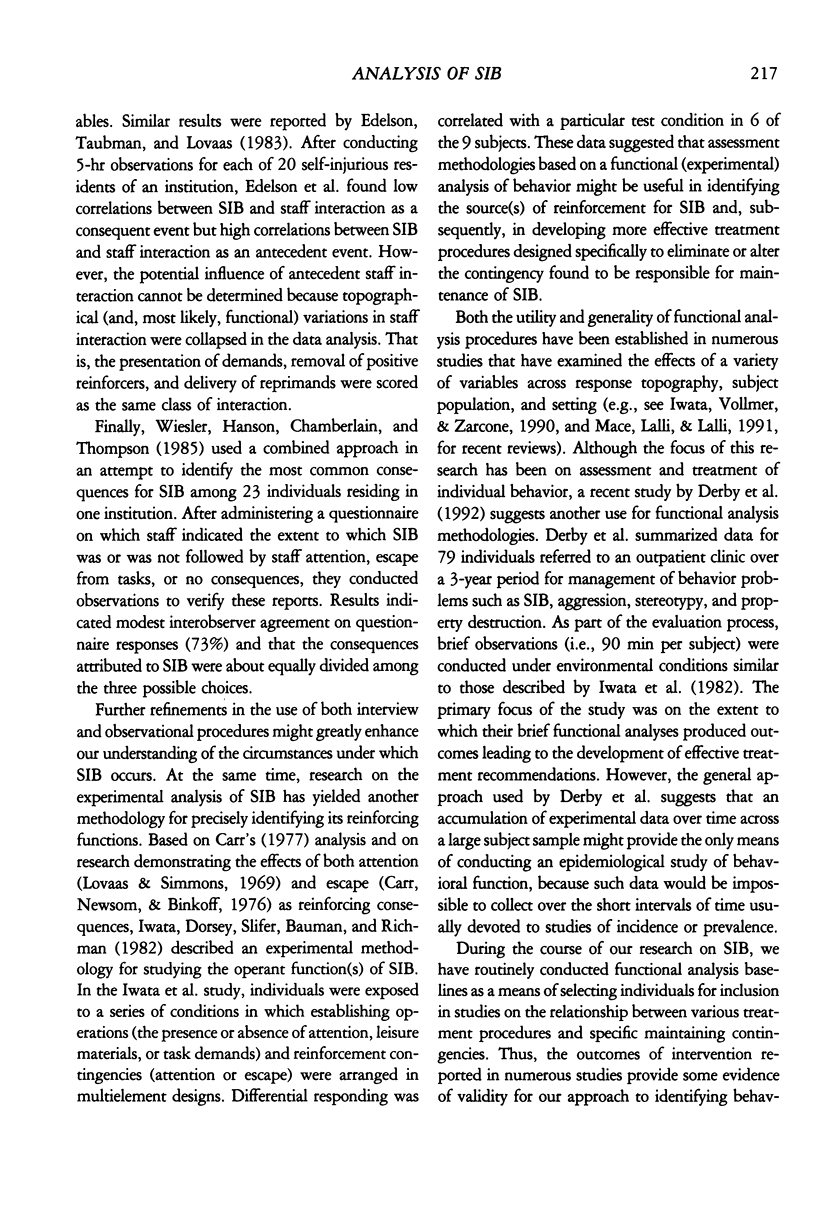
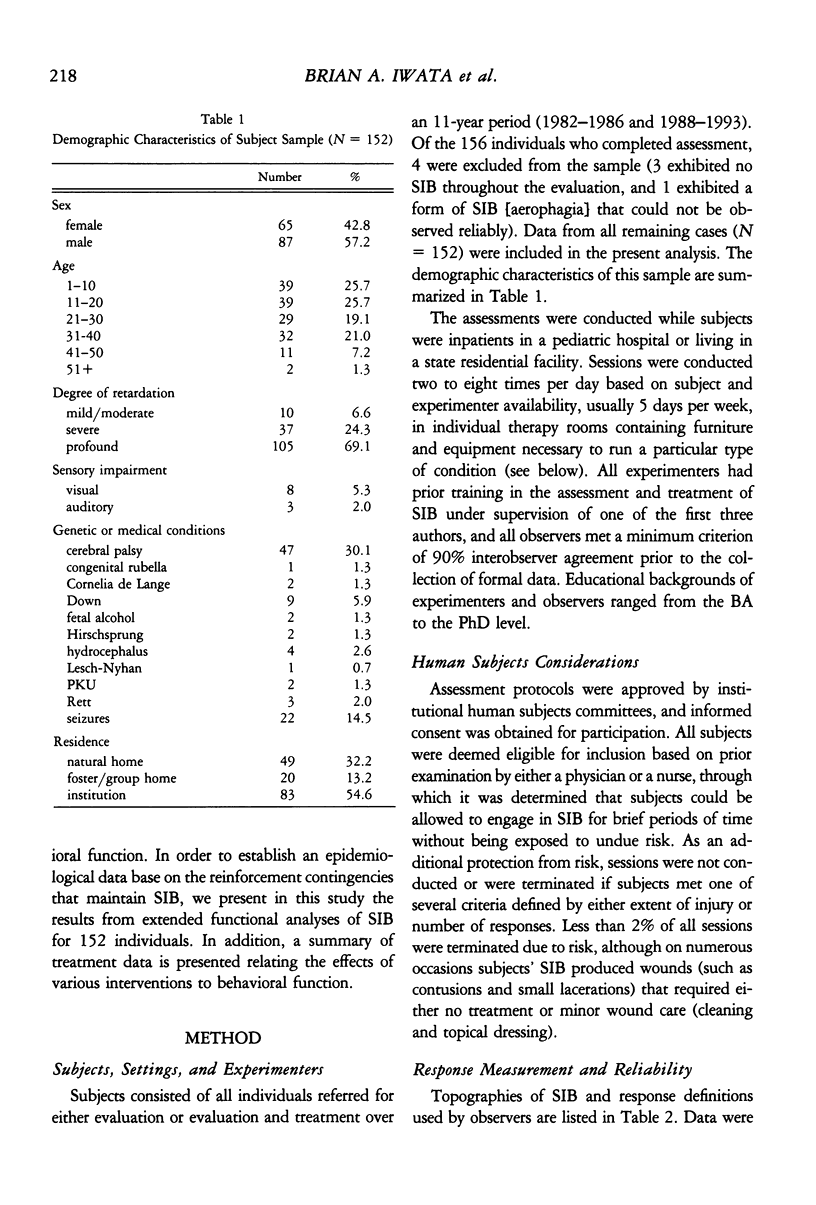
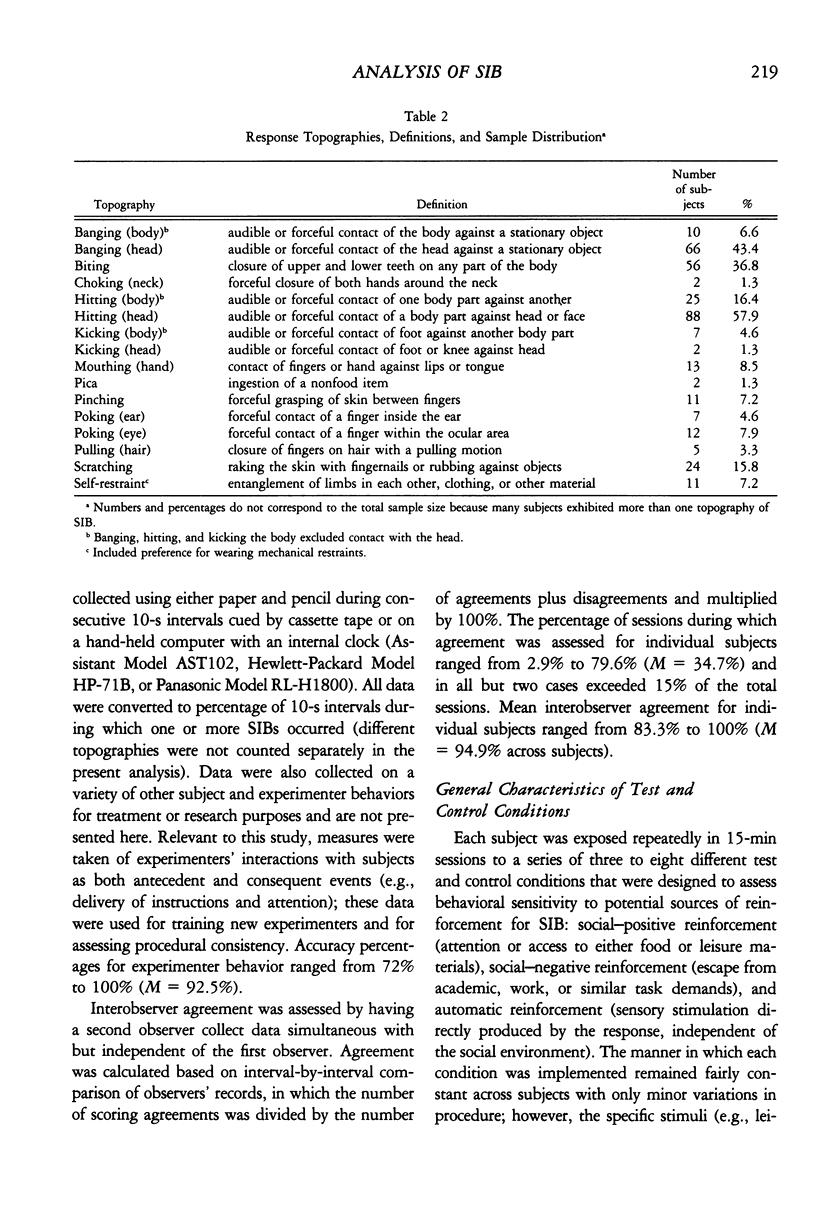
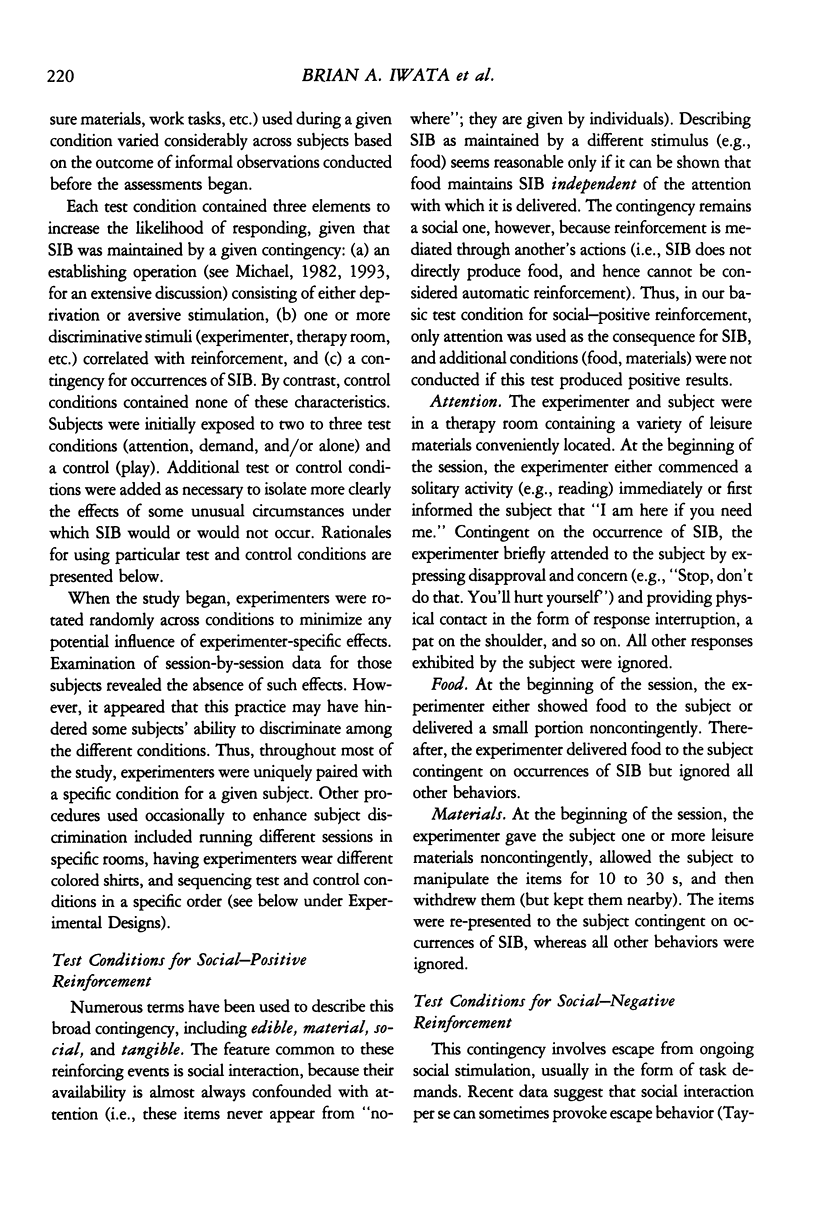
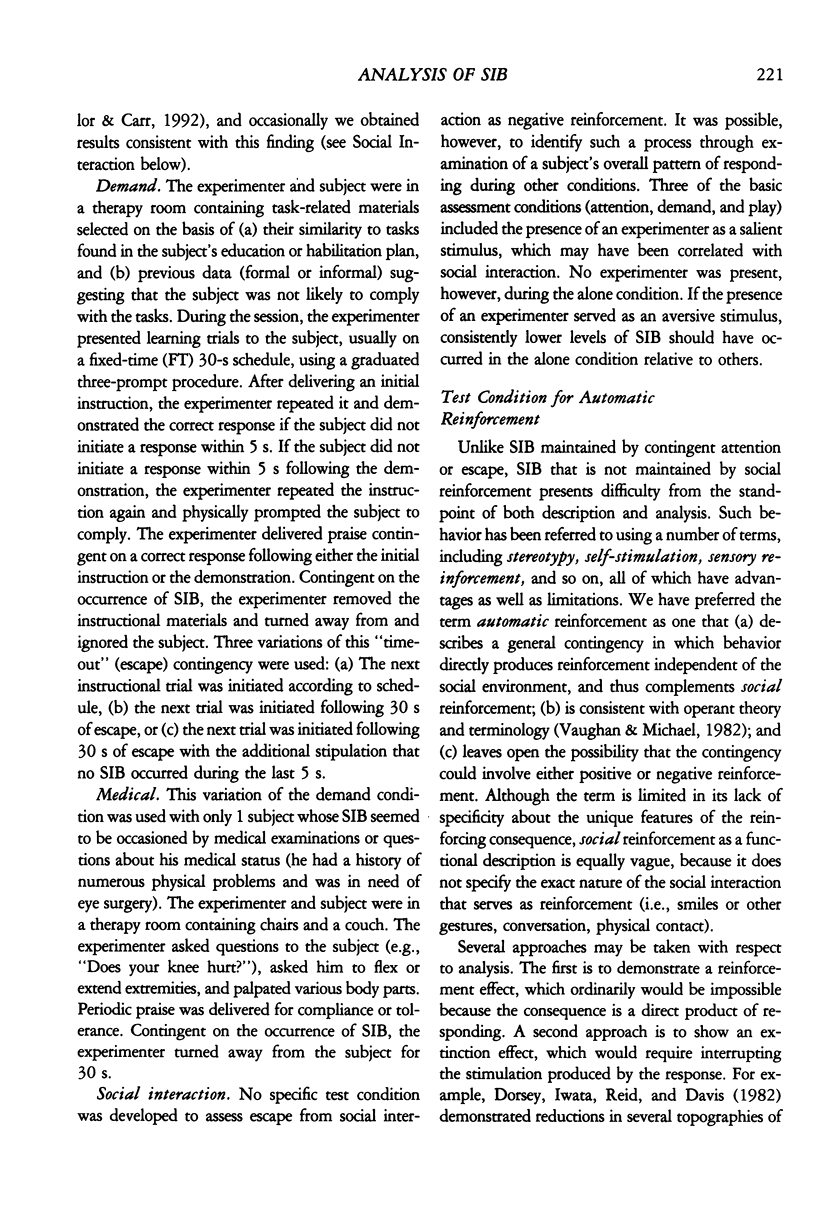
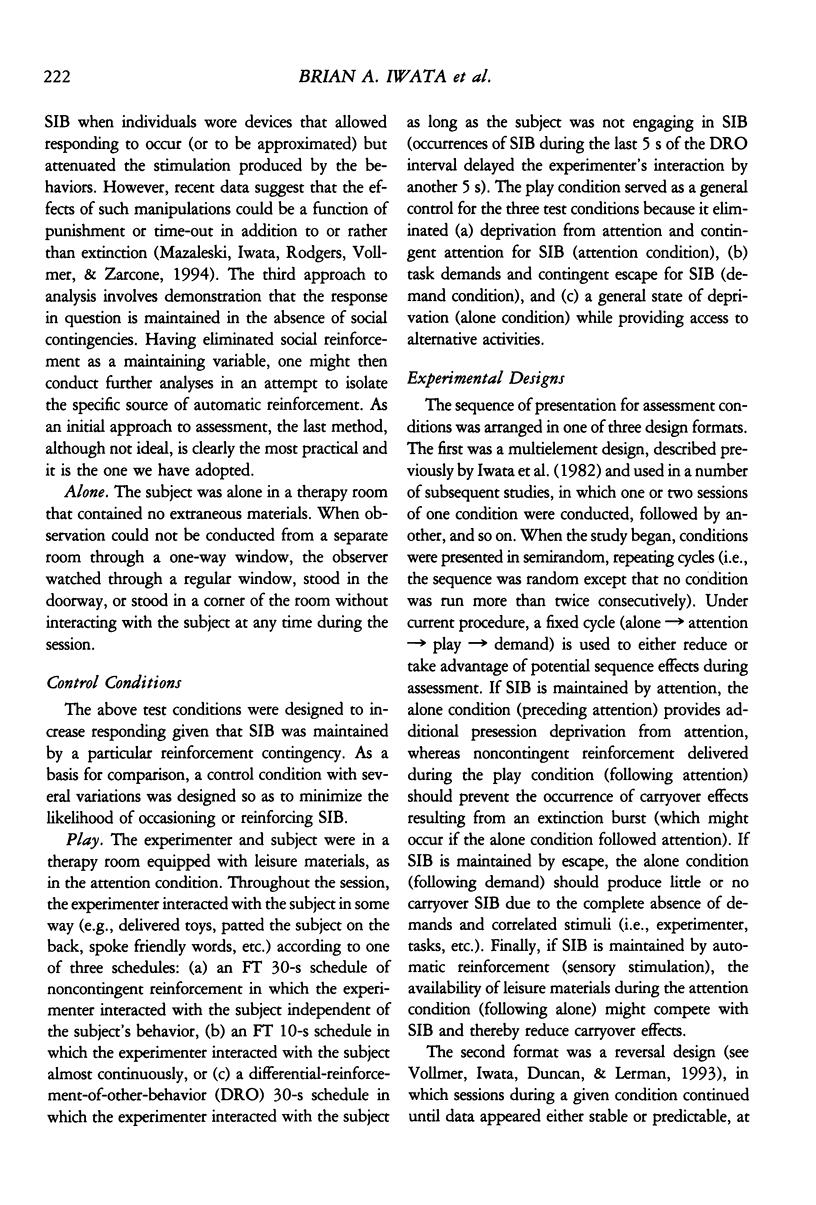
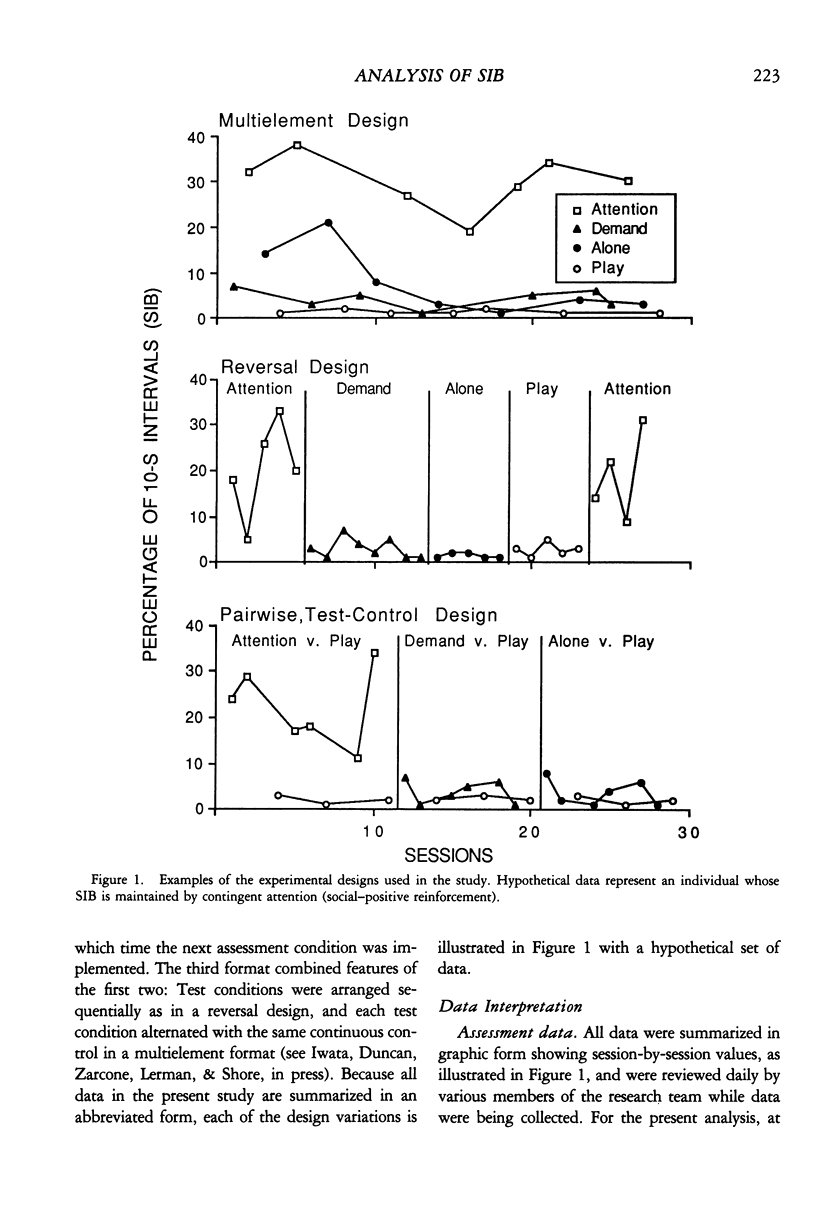
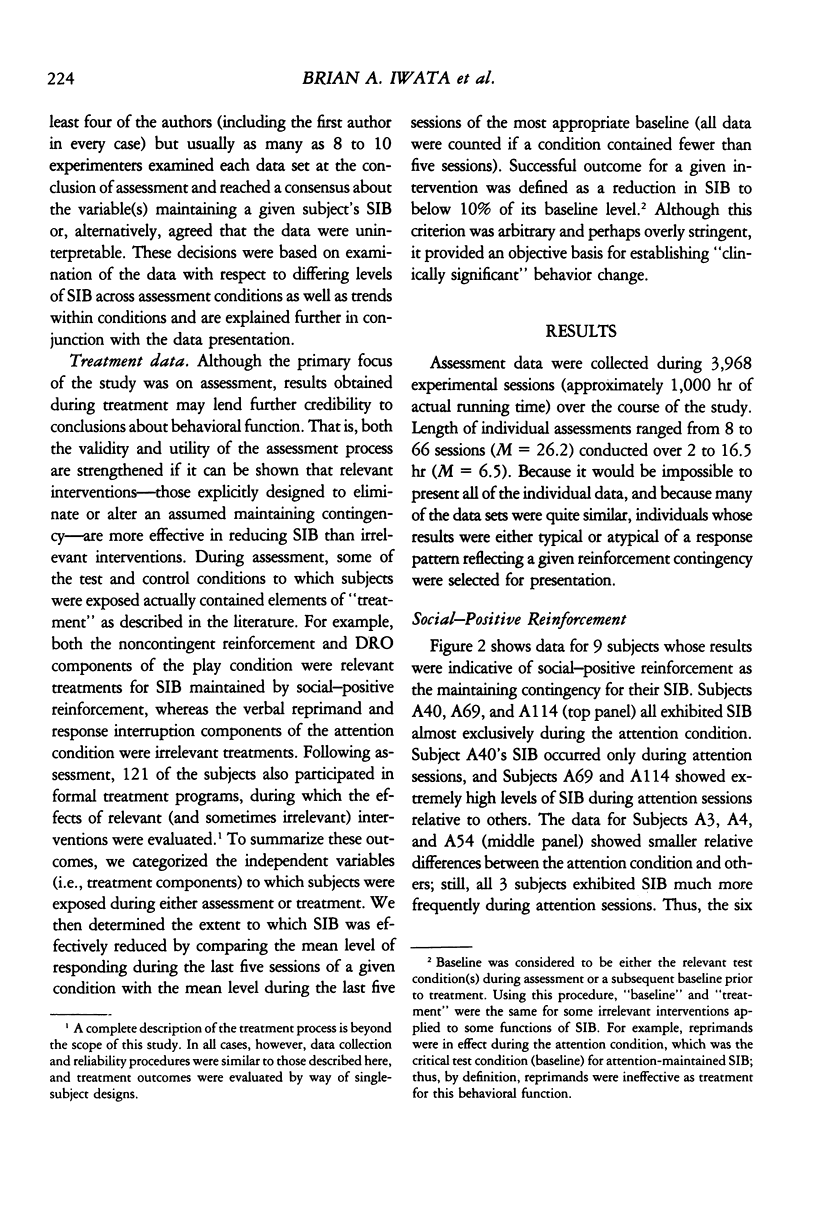
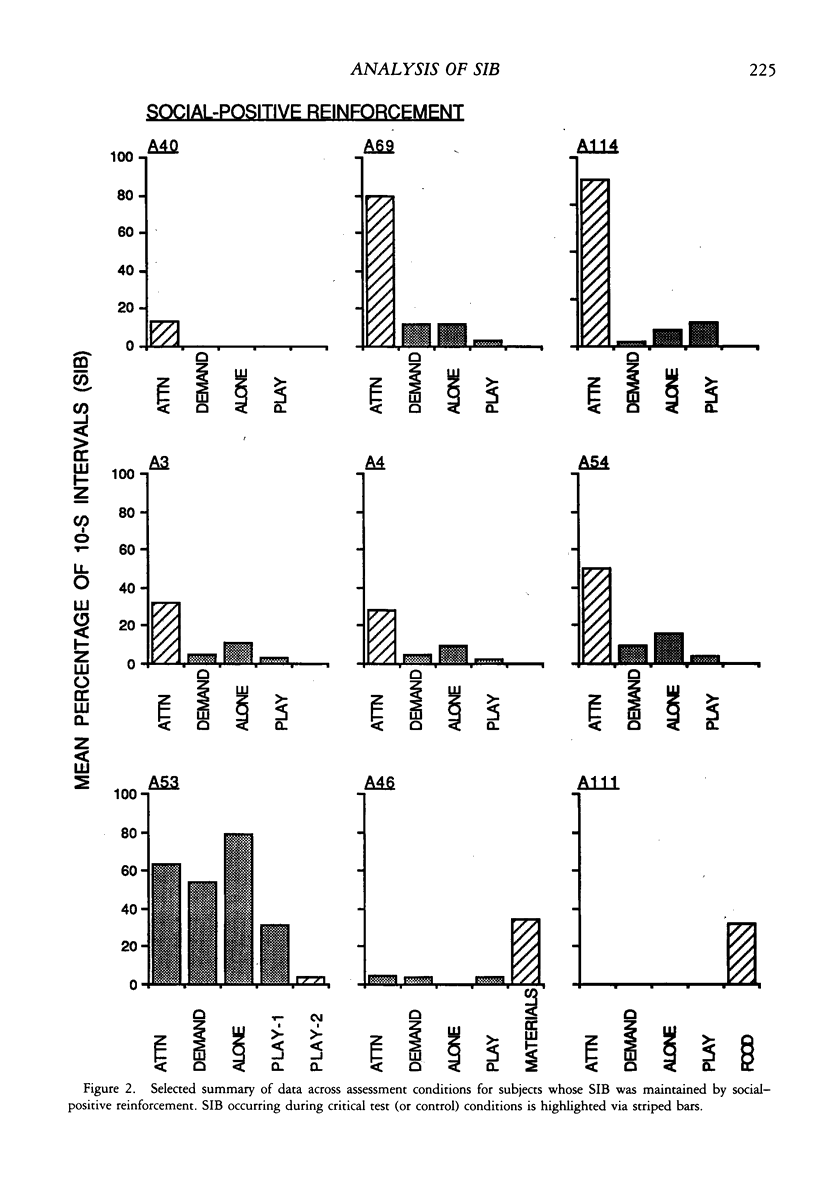
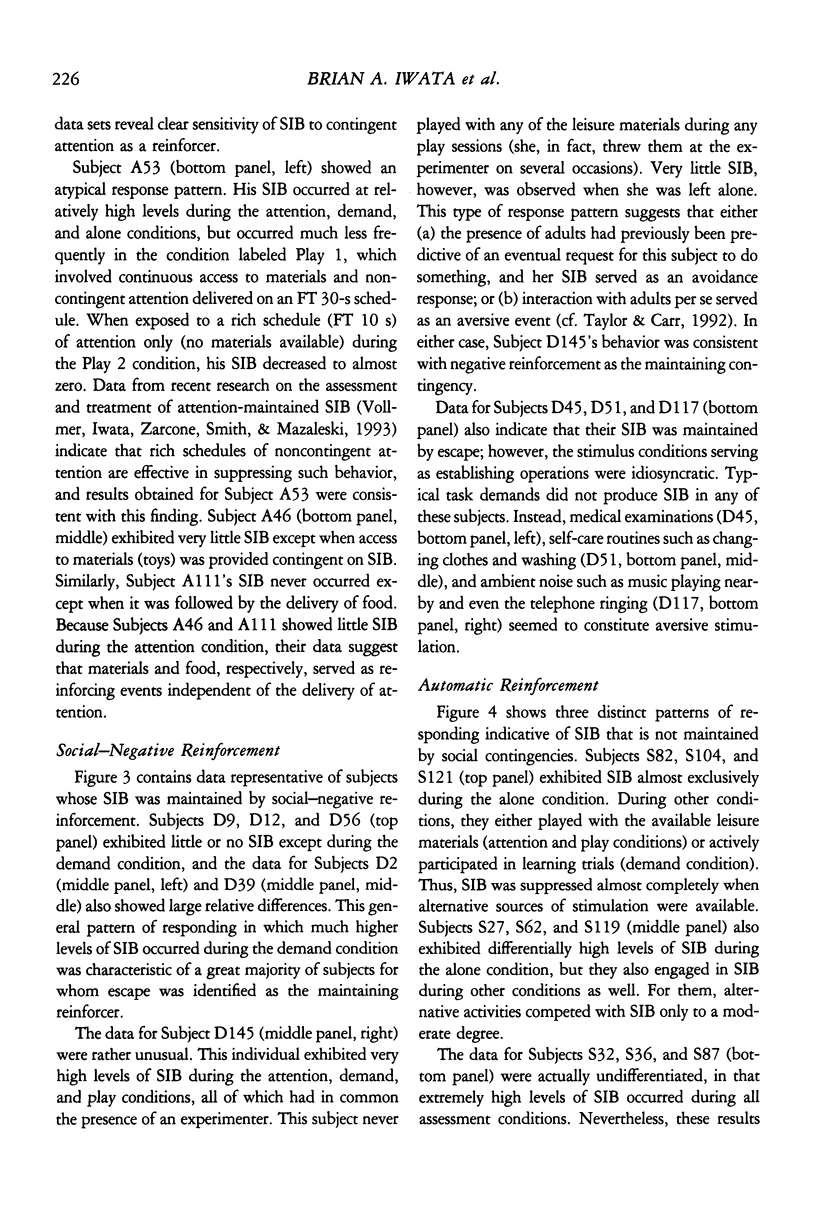
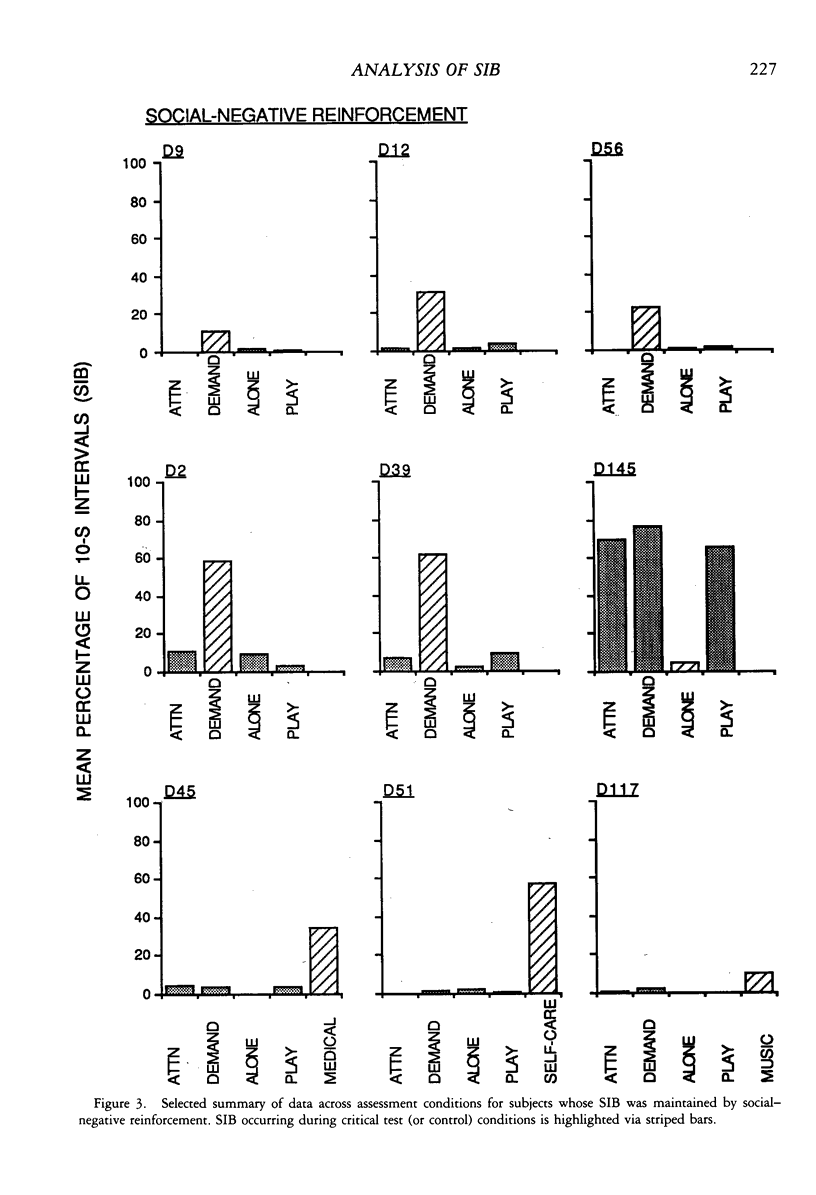
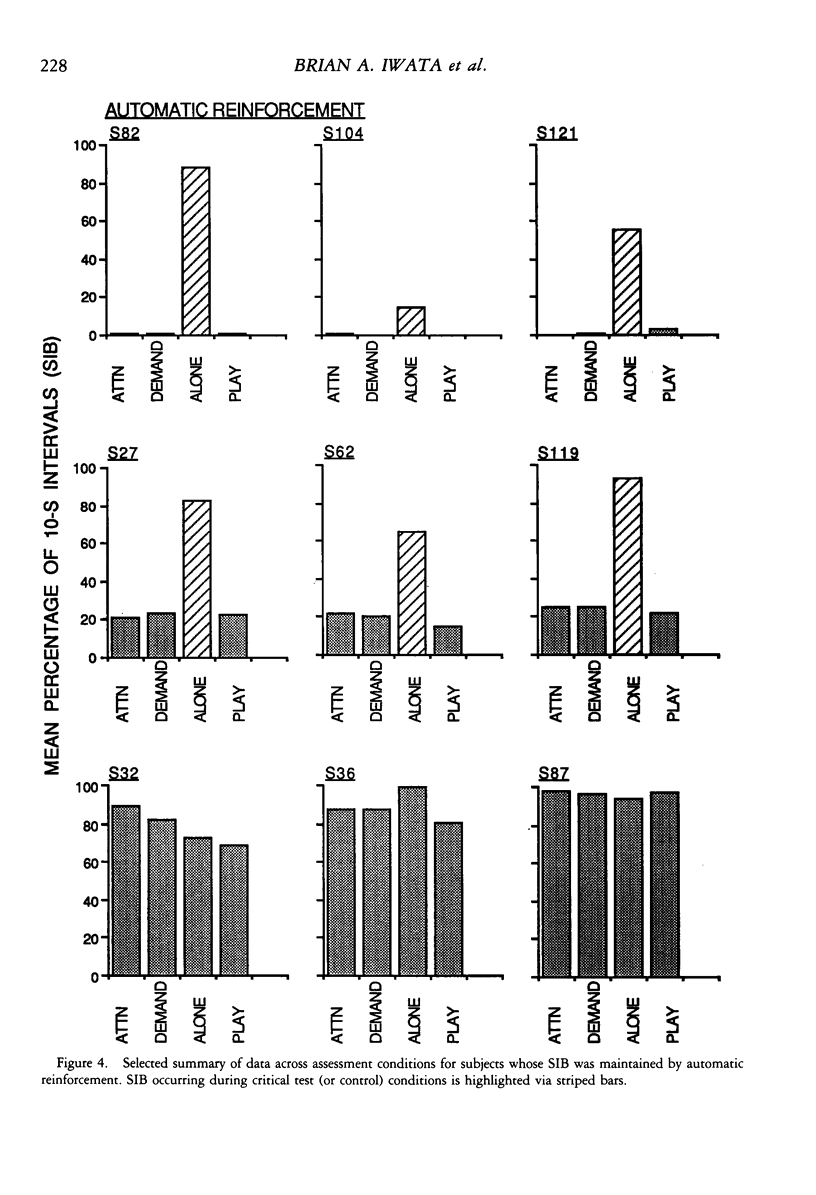
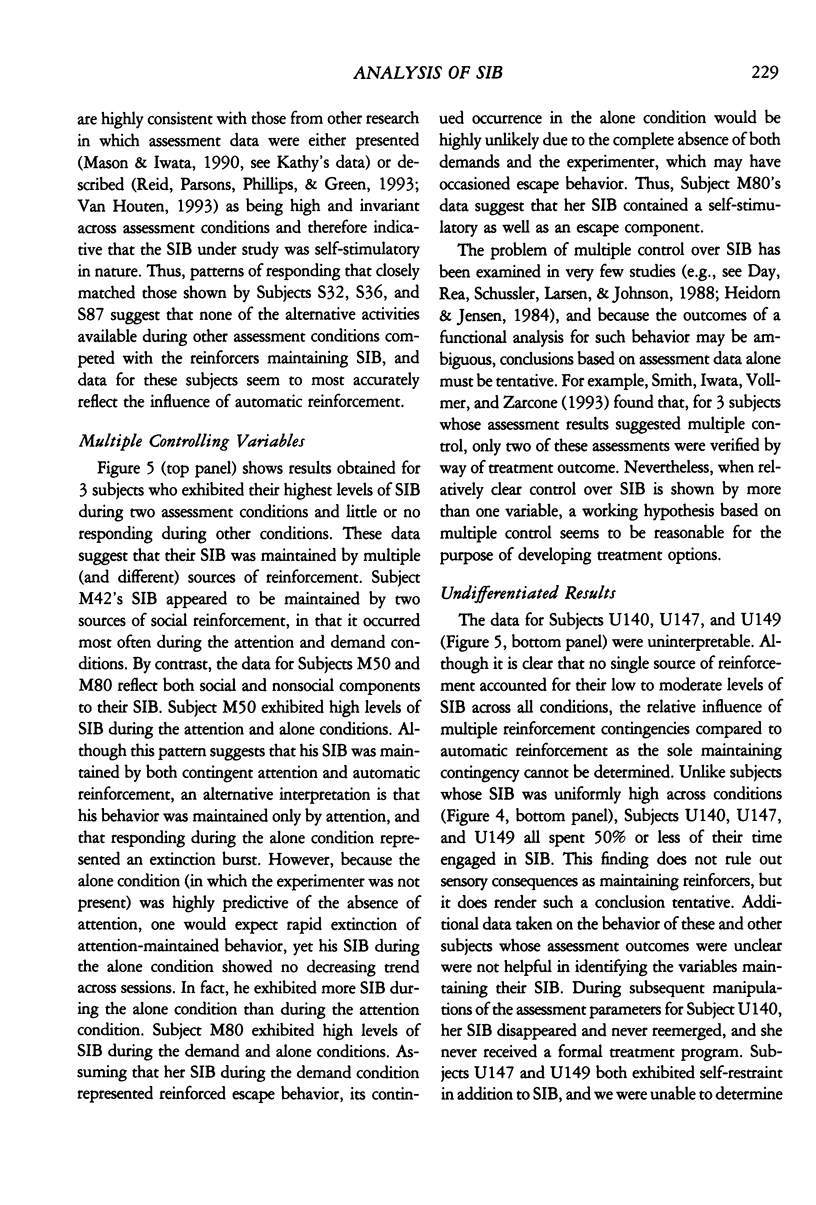
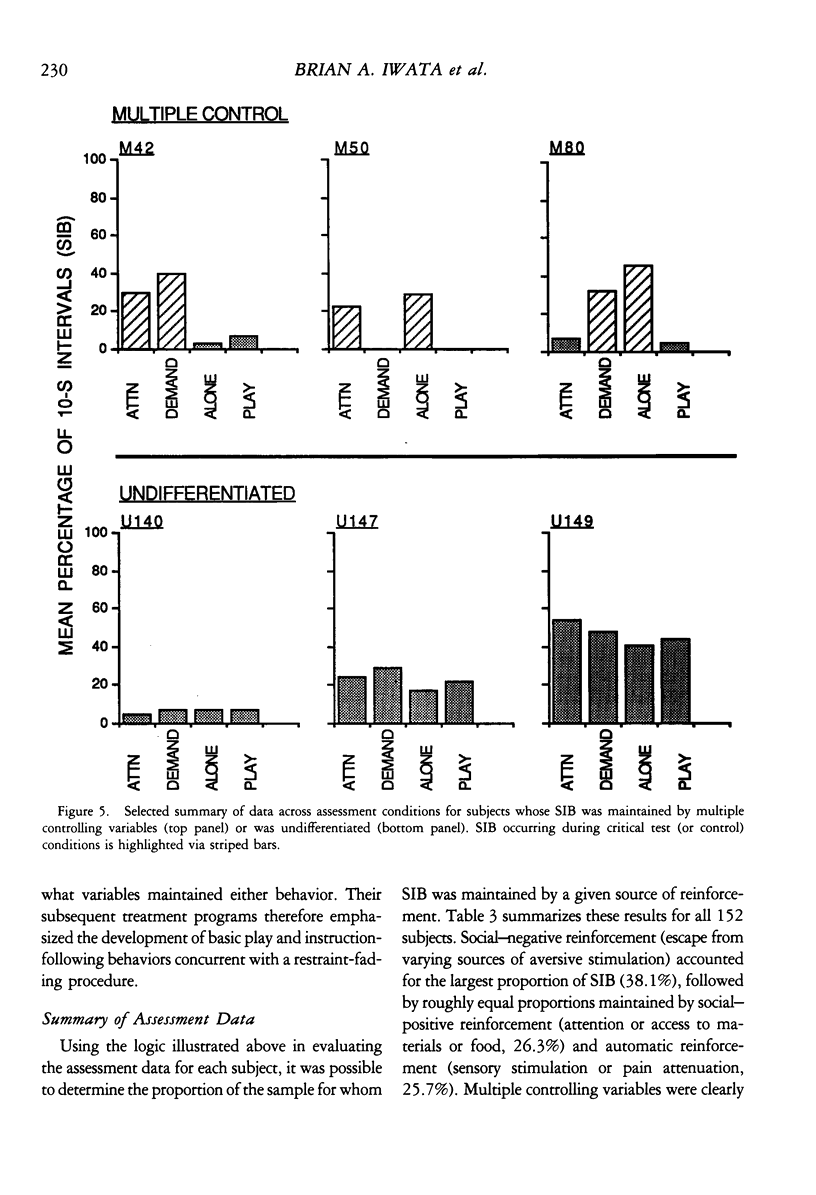
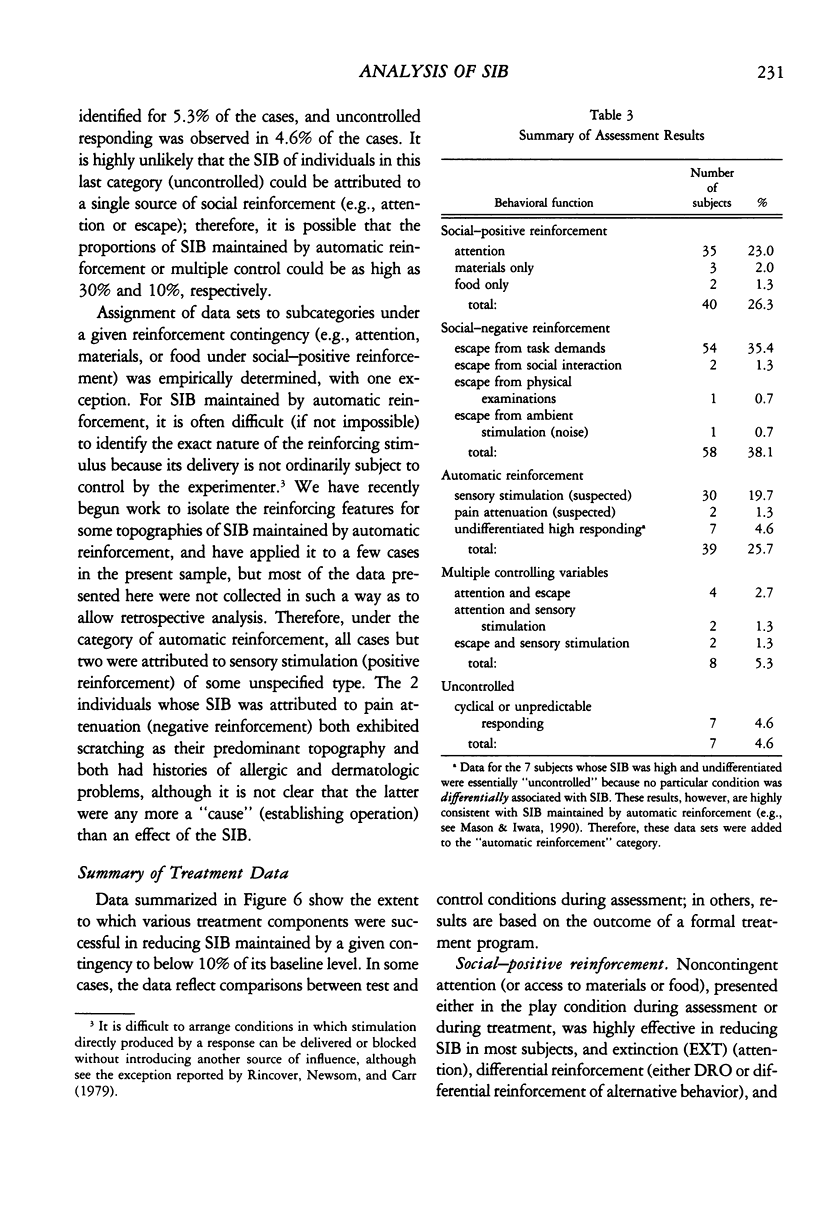
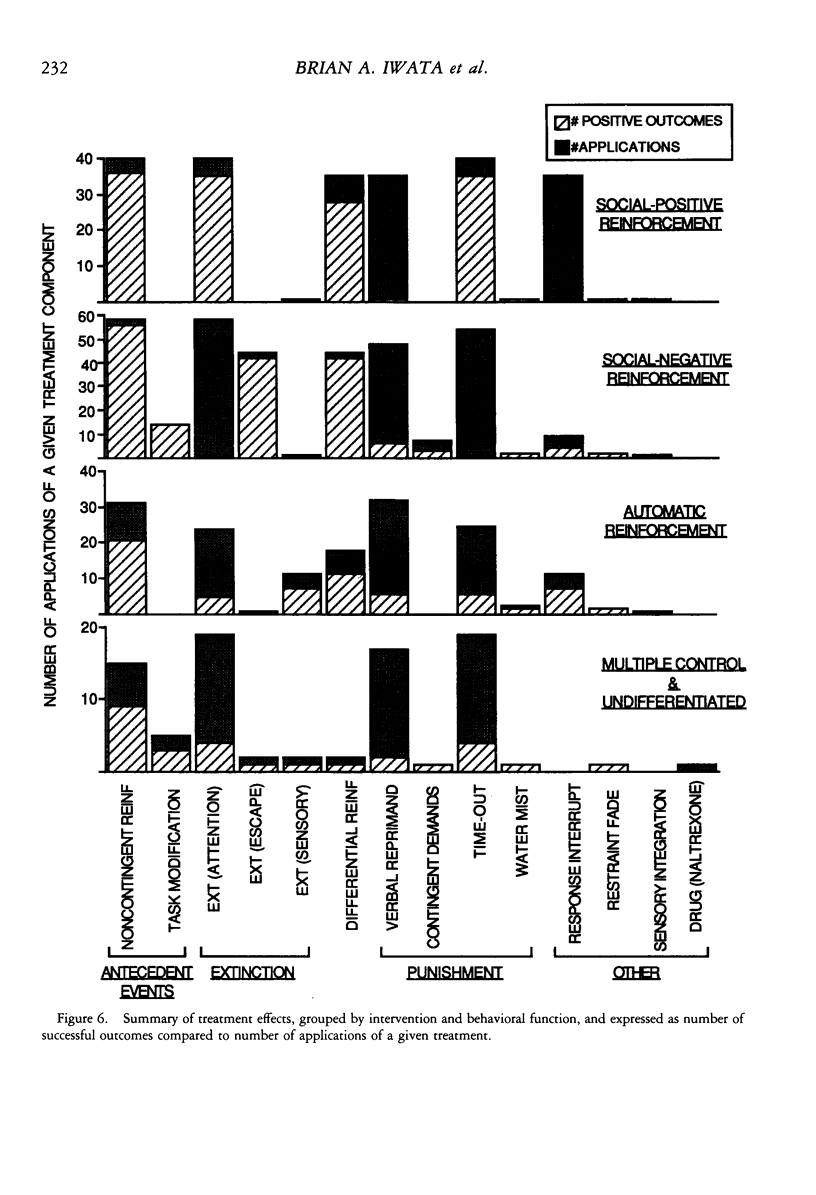
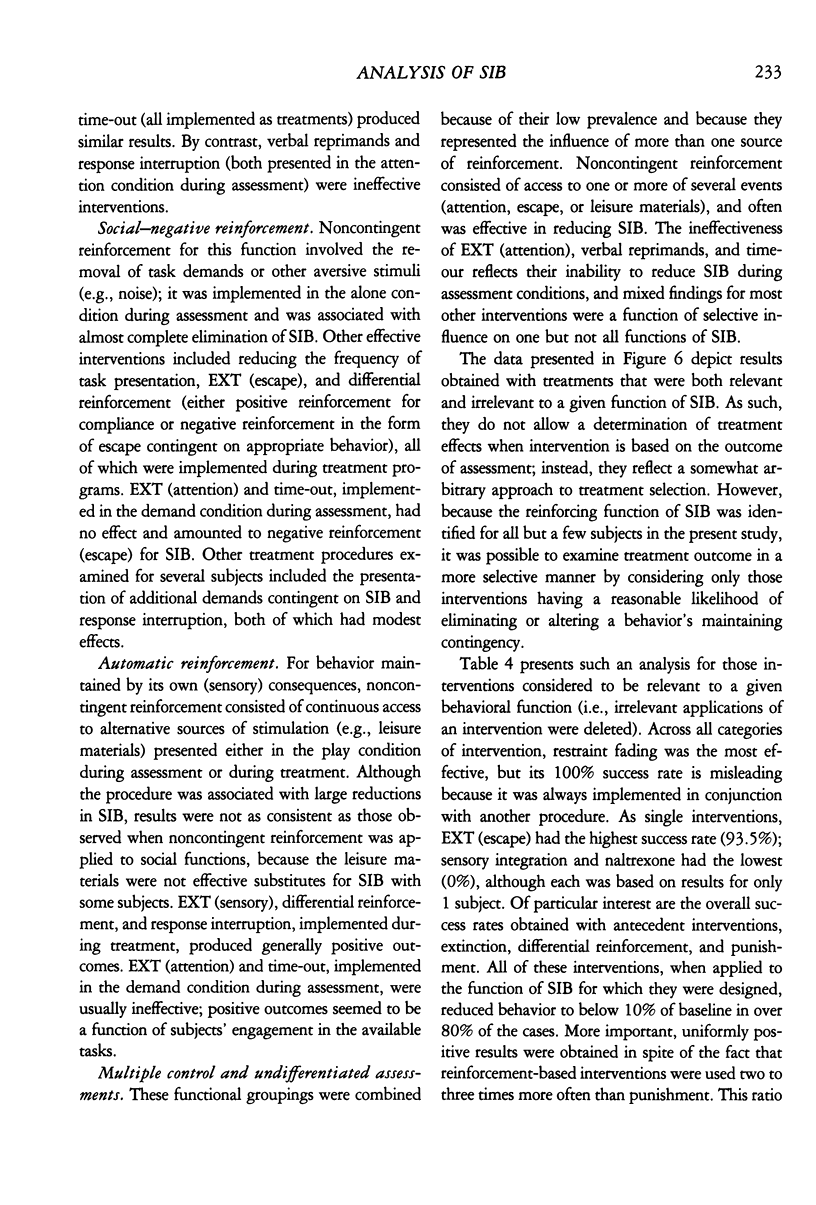
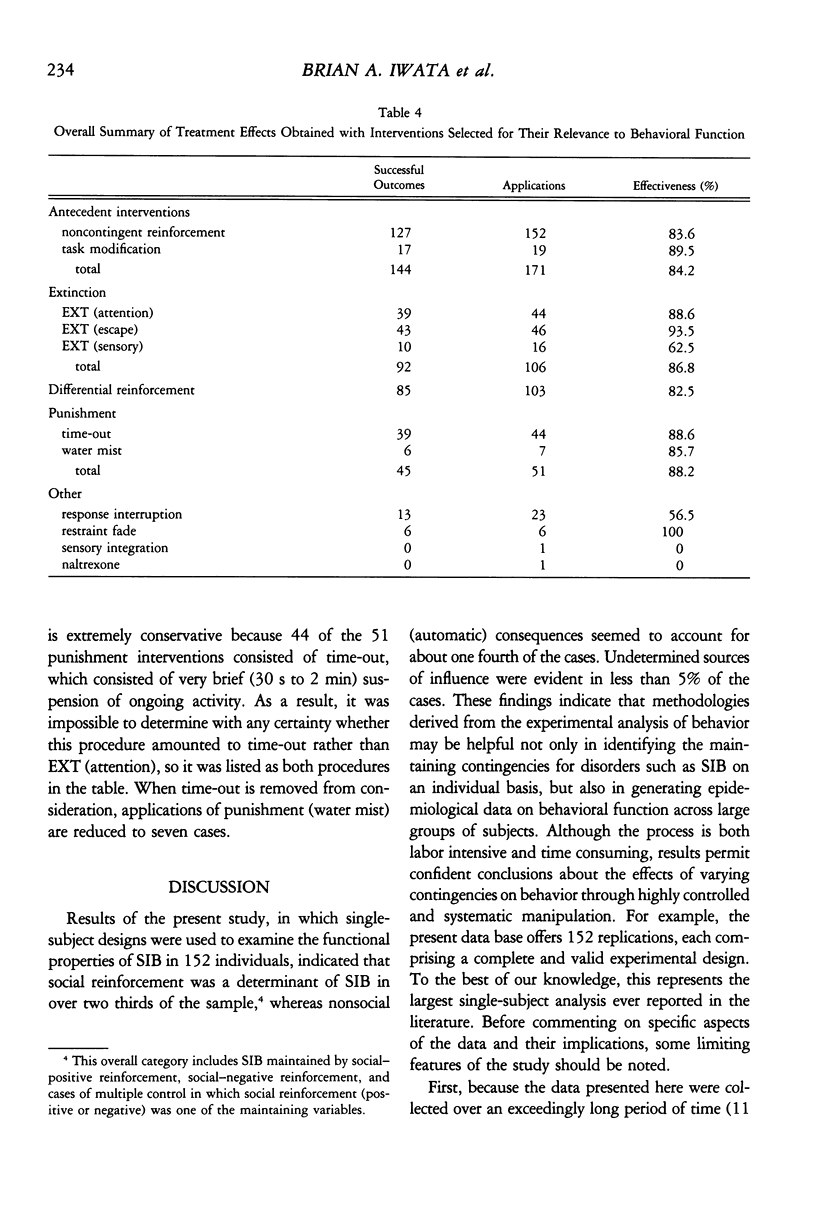
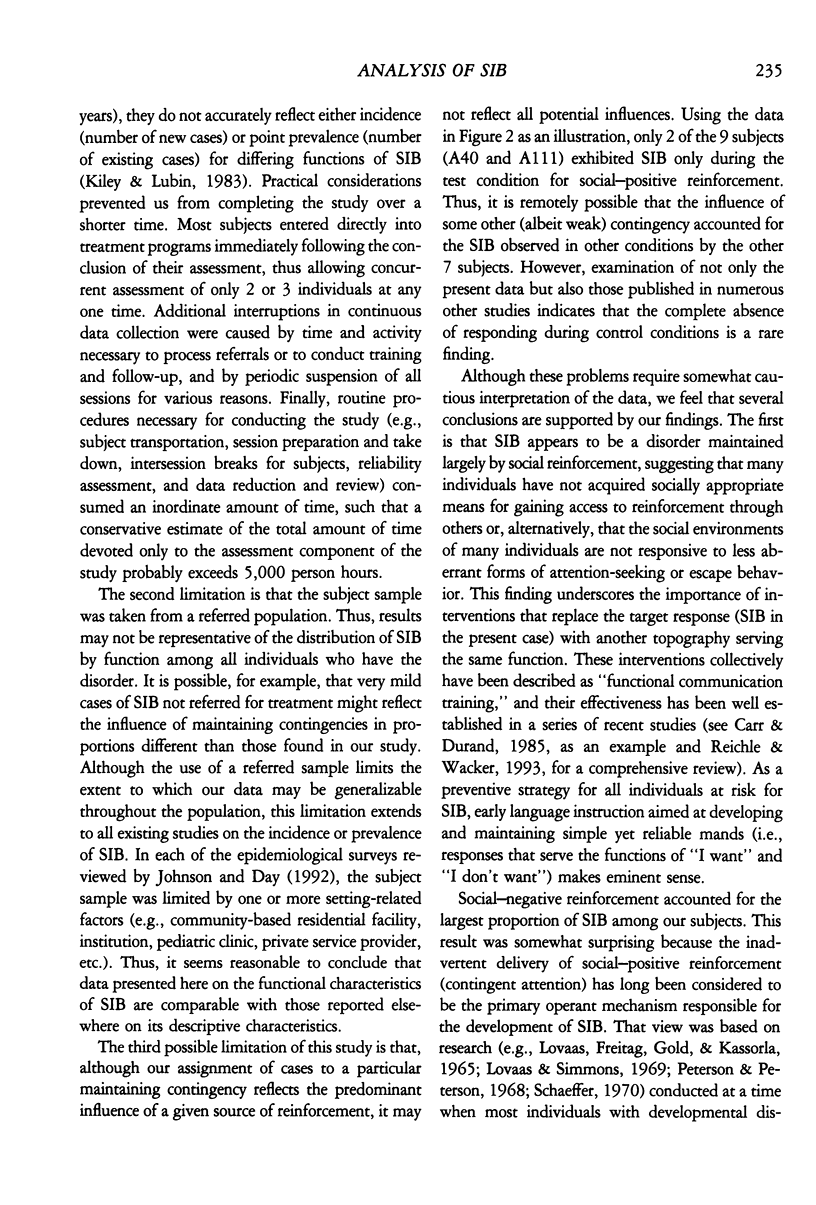
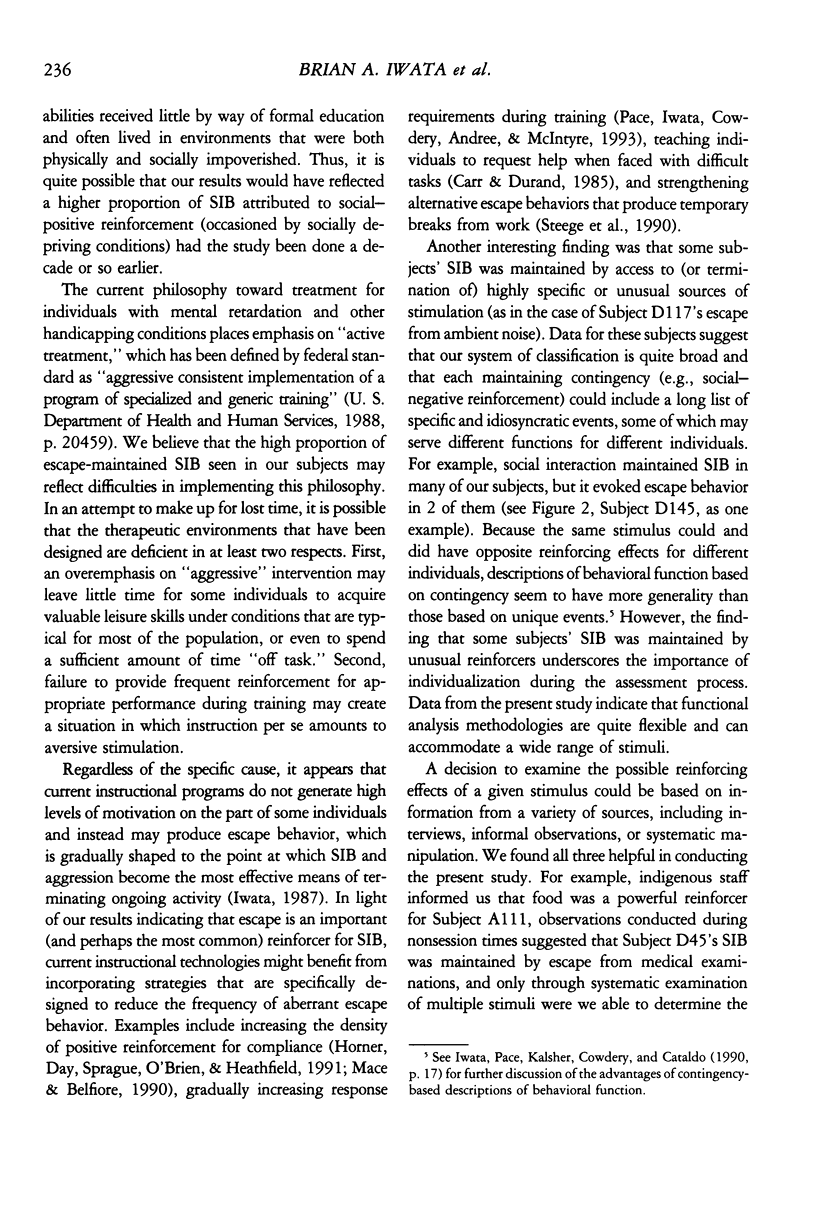
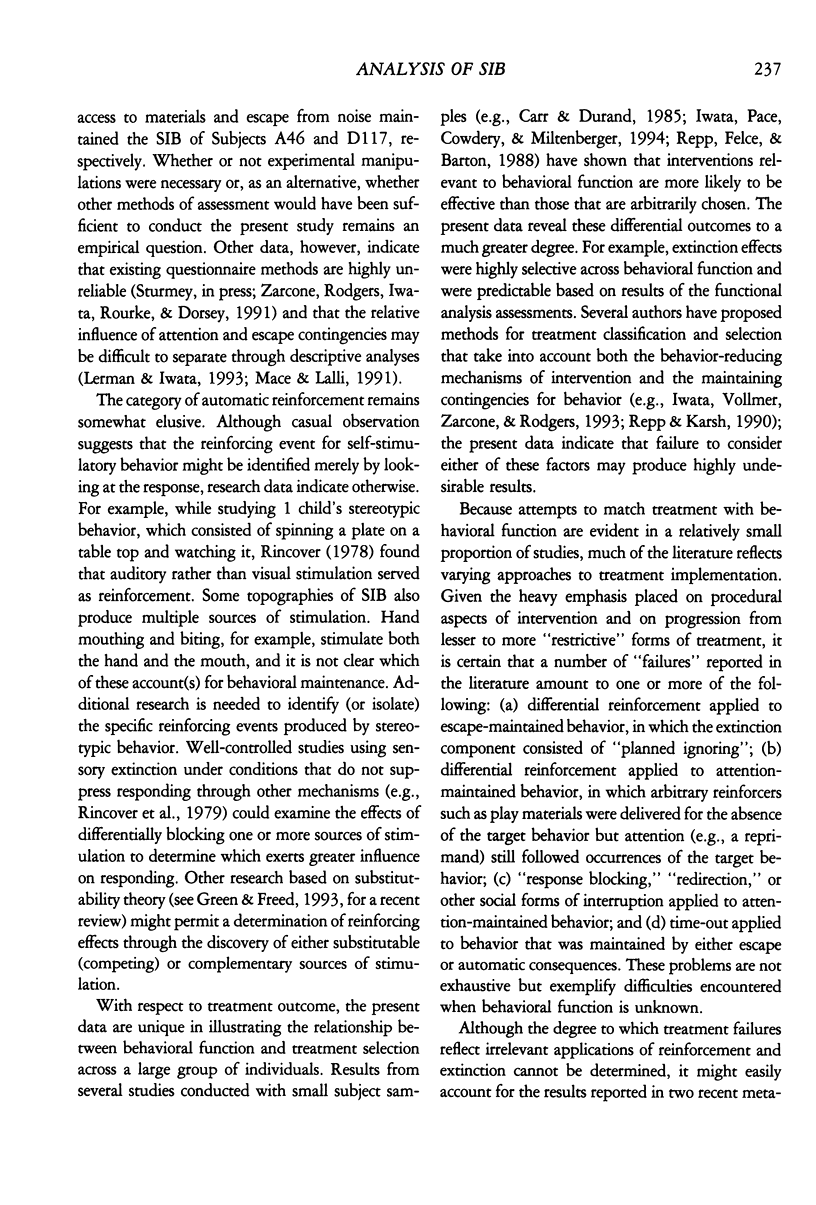
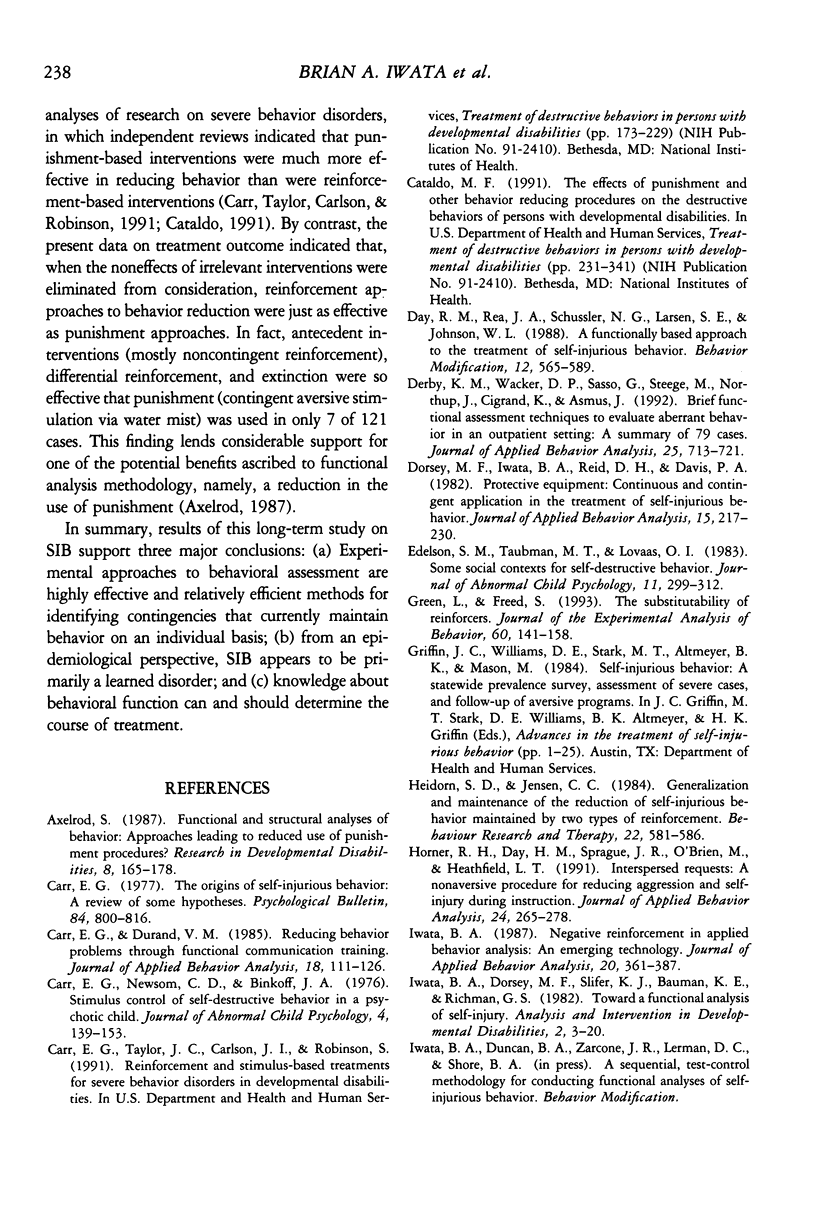
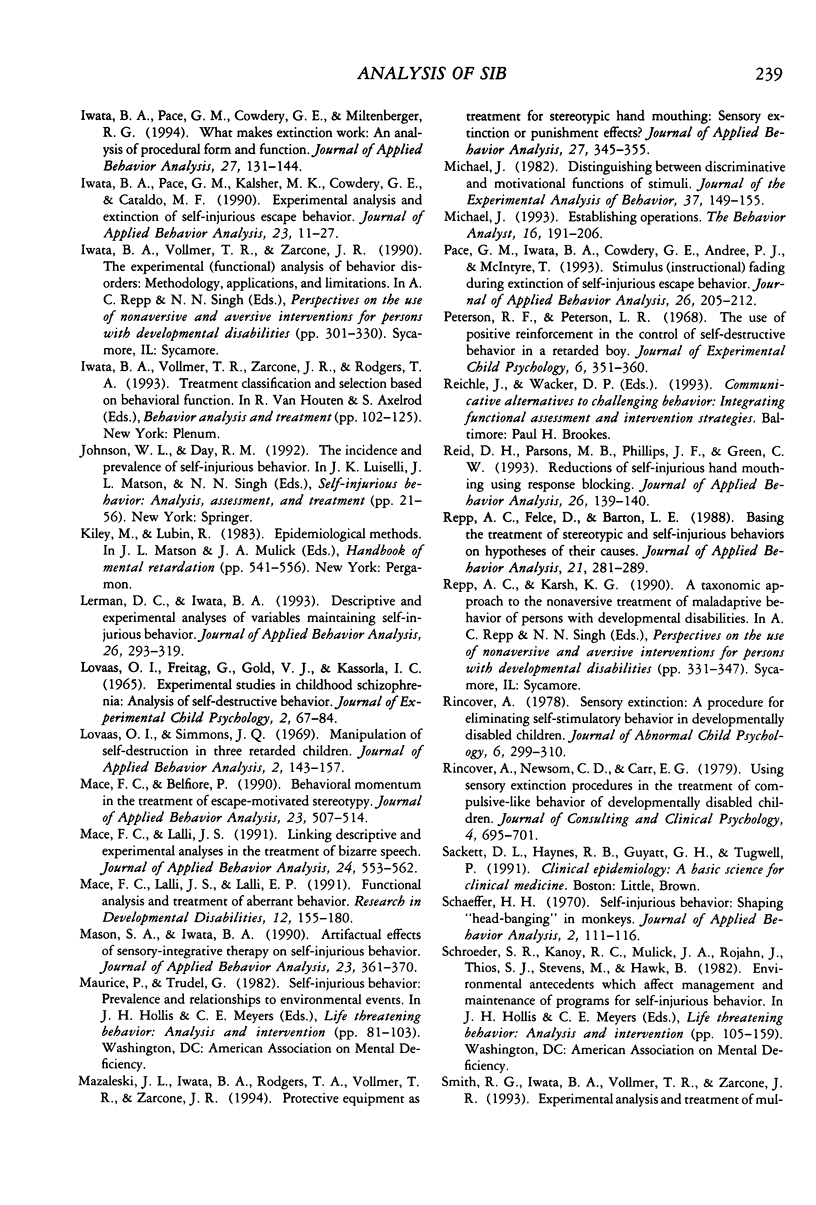
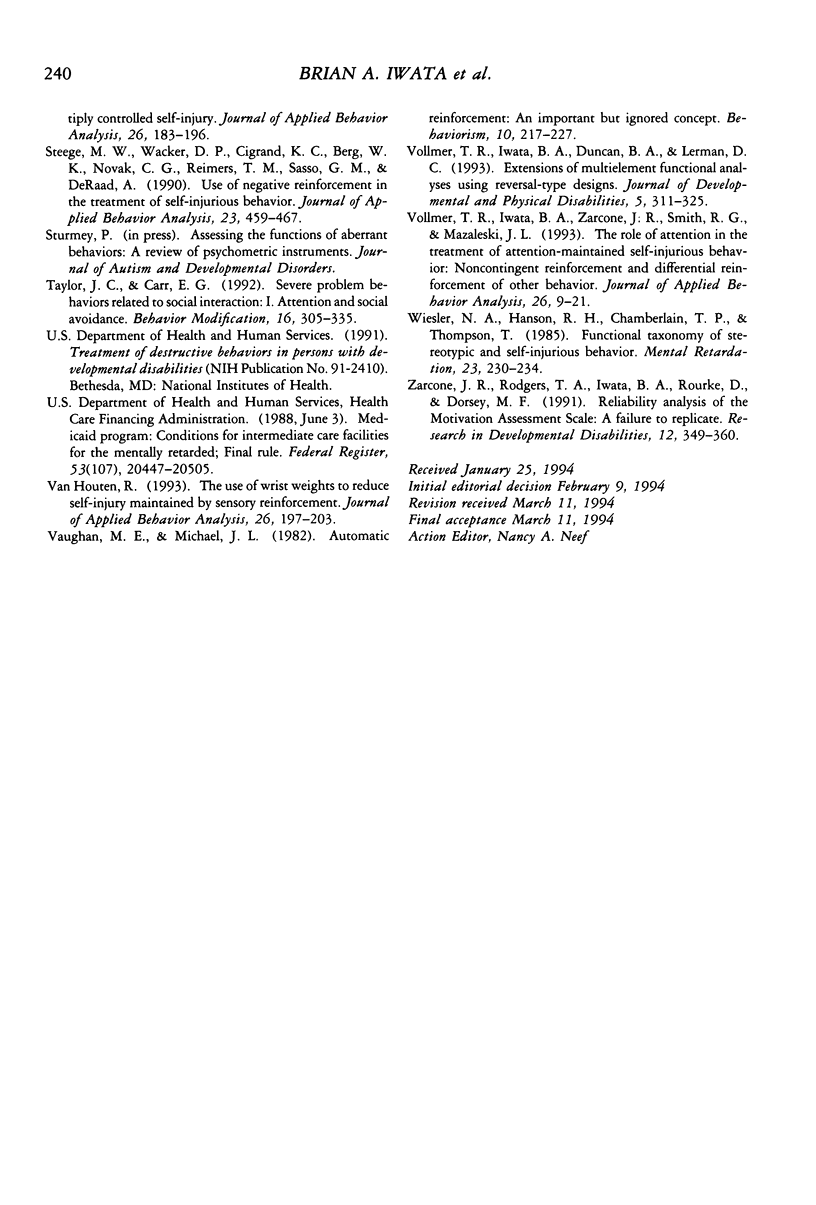
Selected References
These references are in PubMed. This may not be the complete list of references from this article.
- Axelrod S. Functional and structural analyses of behavior: approaches leading to reduced use of punishment procedures? Res Dev Disabil. 1987;8(2):165–178. doi: 10.1016/0891-4222(87)90001-1. [DOI] [PubMed] [Google Scholar]
- Carr E. G., Durand V. M. Reducing behavior problems through functional communication training. J Appl Behav Anal. 1985 Summer;18(2):111–126. doi: 10.1901/jaba.1985.18-111. [DOI] [PMC free article] [PubMed] [Google Scholar]
- Carr E. G., Newsom C. D., Binkoff J. A. Stimulus control of self-destructive behavior in a psychotic child. J Abnorm Child Psychol. 1976;4(2):139–153. doi: 10.1007/BF00916518. [DOI] [PubMed] [Google Scholar]
- Carr E. G. The motivation of self-injurious behavior: a review of some hypotheses. Psychol Bull. 1977 Jul;84(4):800–816. [PubMed] [Google Scholar]
- Day R. M., Rea J. A., Schussler N. G., Larsen S. E., Johnson W. L. A functionally based approach to the treatment of self-injurious behavior. Behav Modif. 1988 Oct;12(4):565–589. doi: 10.1177/01454455880124005. [DOI] [PubMed] [Google Scholar]
- Derby K. M., Wacker D. P., Sasso G., Steege M., Northup J., Cigrand K., Asmus J. Brief functional assessment techniques to evaluate aberrant behavior in an outpatient setting: a summary of 79 cases. J Appl Behav Anal. 1992 Fall;25(3):713–721. doi: 10.1901/jaba.1992.25-713. [DOI] [PMC free article] [PubMed] [Google Scholar]
- Dorsey M. F., Iwata B. A., Reid D. H., Davis P. A. Protective equipment: continuous and contingent application in the treatment of self-injurious behavior. J Appl Behav Anal. 1982 Summer;15(2):217–230. doi: 10.1901/jaba.1982.15-217. [DOI] [PMC free article] [PubMed] [Google Scholar]
- Edelson S. M., Taubman M. T., Lovaas O. I. Some social contexts of self-destructive behavior. J Abnorm Child Psychol. 1983 Jun;11(2):299–311. doi: 10.1007/BF00912093. [DOI] [PubMed] [Google Scholar]
- Green Leonard, Freed Debra E. The substitutability of reinforcers. J Exp Anal Behav. 1993 Jul;60(1):141–158. doi: 10.1901/jeab.1993.60-141. [DOI] [PMC free article] [PubMed] [Google Scholar]
- Heidorn S. D., Jensen C. C. Generalization and maintenance of the reduction of self-injurious behavior maintained by two types of reinforcement. Behav Res Ther. 1984;22(5):581–586. doi: 10.1016/0005-7967(84)90062-7. [DOI] [PubMed] [Google Scholar]
- Horner R. H., Day H. M., Sprague J. R., O'Brien M., Heathfield L. T. Interspersed requests: a nonaversive procedure for reducing aggression and self-injury during instruction. J Appl Behav Anal. 1991 Summer;24(2):265–278. doi: 10.1901/jaba.1991.24-265. [DOI] [PMC free article] [PubMed] [Google Scholar]
- Iwata B. A. Negative reinforcement in applied behavior analysis: an emerging technology. J Appl Behav Anal. 1987 Winter;20(4):361–378. doi: 10.1901/jaba.1987.20-361. [DOI] [PMC free article] [PubMed] [Google Scholar]
- Iwata B. A., Pace G. M., Cowdery G. E., Miltenberger R. G. What makes extinction work: an analysis of procedural form and function. J Appl Behav Anal. 1994 Spring;27(1):131–144. doi: 10.1901/jaba.1994.27-131. [DOI] [PMC free article] [PubMed] [Google Scholar]
- Iwata B. A., Pace G. M., Kalsher M. J., Cowdery G. E., Cataldo M. F. Experimental analysis and extinction of self-injurious escape behavior. J Appl Behav Anal. 1990 Spring;23(1):11–27. doi: 10.1901/jaba.1990.23-11. [DOI] [PMC free article] [PubMed] [Google Scholar]
- Lerman D. C., Iwata B. A. Descriptive and experimental analyses of variables maintaining self-injurious behavior. J Appl Behav Anal. 1993 Fall;26(3):293–319. doi: 10.1901/jaba.1993.26-293. [DOI] [PMC free article] [PubMed] [Google Scholar]
- Lovaas O. I., Simmons J. Q. Manipulation of self-destruction in three retarded children. J Appl Behav Anal. 1969 Fall;2(3):143–157. doi: 10.1901/jaba.1969.2-143. [DOI] [PMC free article] [PubMed] [Google Scholar]
- Mace F. C., Belfiore P. Behavioral momentum in the treatment of escape-motivated stereotypy. J Appl Behav Anal. 1990 Winter;23(4):507–514. doi: 10.1901/jaba.1990.23-507. [DOI] [PMC free article] [PubMed] [Google Scholar]
- Mace F. C., Lalli J. S., Lalli E. P. Functional analysis and treatment of aberrant behavior. Res Dev Disabil. 1991;12(2):155–180. doi: 10.1016/0891-4222(91)90004-c. [DOI] [PubMed] [Google Scholar]
- Mace F. C., Lalli J. S. Linking descriptive and experimental analyses in the treatment of bizarre speech. J Appl Behav Anal. 1991 Fall;24(3):553–562. doi: 10.1901/jaba.1991.24-553. [DOI] [PMC free article] [PubMed] [Google Scholar]
- Mason S. A., Iwata B. A. Artifactual effects of sensory-integrative therapy on self-injurious behavior. J Appl Behav Anal. 1990 Fall;23(3):361–370. doi: 10.1901/jaba.1990.23-361. [DOI] [PMC free article] [PubMed] [Google Scholar]
- Maurice P., Trudel G. Self-injurious behavior prevalence and relationships to environmental events. Monogr Am Assoc Ment Defic. 1982;(5):81–103. [PubMed] [Google Scholar]
- Mazaleski J. L., Iwata B. A., Rodgers T. A., Vollmer T. R., Zarcone J. R. Protective equipment as treatment for stereotypic hand mouthing: sensory extinction or punishment effects? J Appl Behav Anal. 1994 Summer;27(2):345–355. doi: 10.1901/jaba.1994.27-345. [DOI] [PMC free article] [PubMed] [Google Scholar]
- Michael J. Distinguishing between discriminative and motivational functions of stimuli. J Exp Anal Behav. 1982 Jan;37(1):149–155. doi: 10.1901/jeab.1982.37-149. [DOI] [PMC free article] [PubMed] [Google Scholar]
- Pace G. M., Iwata B. A., Cowdery G. E., Andree P. J., McIntyre T. Stimulus (instructional) fading during extinction of self-injurious escape behavior. J Appl Behav Anal. 1993 Summer;26(2):205–212. doi: 10.1901/jaba.1993.26-205. [DOI] [PMC free article] [PubMed] [Google Scholar]
- Peterson R. F., Peterson L. R. The use of positive reinforcement in the control of self-destructive behavior in a retarded boy. J Exp Child Psychol. 1968 Sep;6(3):351–360. doi: 10.1016/0022-0965(68)90116-1. [DOI] [PubMed] [Google Scholar]
- Reid D. H., Parsons M. B., Phillips J. F., Green C. W. Reduction of self-injurious hand mouthing using response blocking. J Appl Behav Anal. 1993 Spring;26(1):139–140. doi: 10.1901/jaba.1993.26-139. [DOI] [PMC free article] [PubMed] [Google Scholar]
- Repp A. C., Felce D., Barton L. E. Basing the treatment of stereotypic and self-injurious behaviors on hypotheses of their causes. J Appl Behav Anal. 1988 Fall;21(3):281–289. doi: 10.1901/jaba.1988.21-281. [DOI] [PMC free article] [PubMed] [Google Scholar]
- Rincover A., Newsom C. D., Carr E. G. Using sensory extinction procedures in the treatment of compulsivelike behavior of developmentally disabled children. J Consult Clin Psychol. 1979 Aug;47(4):695–701. doi: 10.1037//0022-006x.47.4.695. [DOI] [PubMed] [Google Scholar]
- Rincover A. Sensory extinction: a procedure form eliminating self-stimulatory behavior in developmentally disabled children. J Abnorm Child Psychol. 1978 Sep;6(3):299–310. doi: 10.1007/BF00924733. [DOI] [PubMed] [Google Scholar]
- Schroeder S. R., Kanoy R. C., Mulick J. A., Rojahn J., Thios S. J., Stephens M., Hawk B. Environmental antecedents which affect management and maintenance of programs for self-injurious behavior. Monogr Am Assoc Ment Defic. 1982;(5):105–159. [PubMed] [Google Scholar]
- Smith R. G., Iwata B. A., Vollmer T. R., Zarcone J. R. Experimental analysis and treatment of multiply controlled self-injury. J Appl Behav Anal. 1993 Summer;26(2):183–196. doi: 10.1901/jaba.1993.26-183. [DOI] [PMC free article] [PubMed] [Google Scholar]
- Steege M. W., Wacker D. P., Cigrand K. C., Berg W. K., Novak C. G., Reimers T. M., Sasso G. M., DeRaad A. Use of negative reinforcement in the treatment of self-injurious behavior. J Appl Behav Anal. 1990 Winter;23(4):459–467. doi: 10.1901/jaba.1990.23-459. [DOI] [PMC free article] [PubMed] [Google Scholar]
- Taylor J. C., Carr E. G. Severe problem behaviors related to social interaction. 1: Attention seeking and social avoidance. Behav Modif. 1992 Jul;16(3):305–335. doi: 10.1177/01454455920163002. [DOI] [PubMed] [Google Scholar]
- Van Houten R. The use of wrist weights to reduce self-injury maintained by sensory reinforcement. J Appl Behav Anal. 1993 Summer;26(2):197–203. doi: 10.1901/jaba.1993.26-197. [DOI] [PMC free article] [PubMed] [Google Scholar]
- Vollmer T. R., Iwata B. A., Zarcone J. R., Smith R. G., Mazaleski J. L. The role of attention in the treatment of attention-maintained self-injurious behavior: noncontingent reinforcement and differential reinforcement of other behavior. J Appl Behav Anal. 1993 Spring;26(1):9–21. doi: 10.1901/jaba.1993.26-9. [DOI] [PMC free article] [PubMed] [Google Scholar]
- Wieseler N. A., Hanson R. H., Chamberlain T. P., Thompson T. Functional taxonomy of stereotypic and self-injurious behavior. Ment Retard. 1985 Oct;23(5):230–234. [PubMed] [Google Scholar]
- Zarcone J. R., Rodgers T. A., Iwata B. A., Rourke D. A., Dorsey M. F. Reliability analysis of the Motivation Assessment Scale: a failure to replicate. Res Dev Disabil. 1991;12(4):349–360. doi: 10.1016/0891-4222(91)90031-m. [DOI] [PubMed] [Google Scholar]


